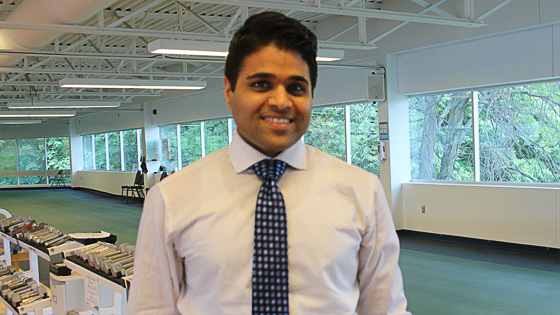
In a study published this summer, Dr. Ravi Bajaj (above) and Dr. David Alter explored whether patients with abnormal heart rhythms can safely participate in exercise therapy. (Photo: UHN)
While exercise may be one of the most encouraged defences against chronic conditions including heart disease, cancer and stroke – when faced with electrical diseases of the heart, such as atrial fibrillation and ventricular tachycardia, people often perceive exercise as "too risky" and fear a harmful outcome if they push themselves too hard.
Is it safe for patients with abnormal heart rhythms, also known as arrhythmias, to participate in exercise therapy?
What is an arrhythmia? A normal resting heart rate for adults ranges from 60 to 100 beats per minute. A cardiac arrhythmia means that the heartbeat is irregular and moving too fast or too slow. A heart rate that is too fast – above 100 beats per minute in adults – is called tachycardia and a heart rate that is too slow – below 60 beats per minute – is called bradycardia.
Dr. Ravi Bajaj, Electrophysiology and Cardiac Rehab Clinical Fellow, and Dr. David Alter, Senior Scientist at Toronto Rehabilitation Institute-UHN set out to find the answer in a study published in the
International Journal of Physical Medicine & Rehabilitation earlier this summer.
"To answer this question, we wanted to look at the patients at the highest risk of developing life threatening arrhythmias, specifically those with an Implantable Cardioverter Defibrillator (ICD)," says Dr. Bajaj.
An ICD is a small device that's placed in the chest or abdomen; doctors use the device to help treat arrhythmias.
"We wanted to find out if these high-risk patients were being exercised in cardiac rehabilitation programs, and if so, whether it was safe."
Not unexpectedly, the study found that patients with an ICD were at a higher risk of experiencing an adverse event, for example heart failure or hospitalization, than patients who did not use an ICD – reflecting their increased baseline risk.
The most illuminating finding, however, was the comparison among ICD patients who exercised versus those who did not.
The study revealed that exercise did not increase the risk of experiencing a negative cardiovascular outcome – meaning exercise in this high-risk cardiac patient population can indeed be safe and may actually prevent adverse events from occurring in the future.
Patients at risk of cardiac arrhythmias should therefore not be excluded from participating in cardiac rehabilitation programs based on their perceived risk alone.
First-of-its kind fellowship established in Ontario
"While our story looks encouraging and we now know that exercise does not increase the risk of a cardiovascular event in high risk arrhythmia patients – a more comprehensive surveillance strategy is needed so we can better understand the needs of this very high-risk patient population," says Dr. Alter.
"We don't currently have the tools in place to monitor these ICD patients and examine their devices to understand what types of exercise are most beneficial and safest."
But that's all about to change.
To address this need, Dr. Bajaj started a first-of-its kind fellowship in Ontario specializing in electrophysiology and cardiac rehab. In his first year, Dr. Bajaj will complete a one-year clinical fellowship in electrophysiology at Sunnybrook Health Sciences to learn about cardiac arrhythmias and the devices used to diagnose and treat them.
Dr. Bajaj will see and treat high risk arrhythmia patients and participate in operating room procedures including implanting pacemakers, defibrillators, and cardiac resynchronization devices.
Developing a national strategy for cardiac rehab in high-risk patients
"Currently, we do not have an ICD registry of patients or a strategy in Ontario or Canada for evaluating these high-risk populations – my hope is that Ravi [Dr. Bajaj] is going to pioneer this research program at Toronto Rehab," says Dr. Alter.
"After one year, Ravi will be an expert on every device that you can implant and program, and will spend his remaining time during his first year beginning to scope out and implement a research plan for his forthcoming years at Toronto Rehab," says Dr. Alter.
After the first year of his clinical fellowship, Dr. Bajaj intends to shift his focus to cardiac rehabilitation research as it relates to arrhythmia patients. He will start putting together a consortium of researchers to launch an ICD registry of patients to help inform a larger surveillance strategy on a provincial and national scale.
"There is clear evidence that this is an under-represented rehab patient population – and because there is a lack of research in this area, patients are still afraid to exercise and are not benefitting from cardiac rehabilitation programs," says Dr. Bajaj.
"Our goal is to cement this knowledge that it is safe to exercise – and ultimately, safely design a cardiac rehab program tailored to this high-risk patient population."
